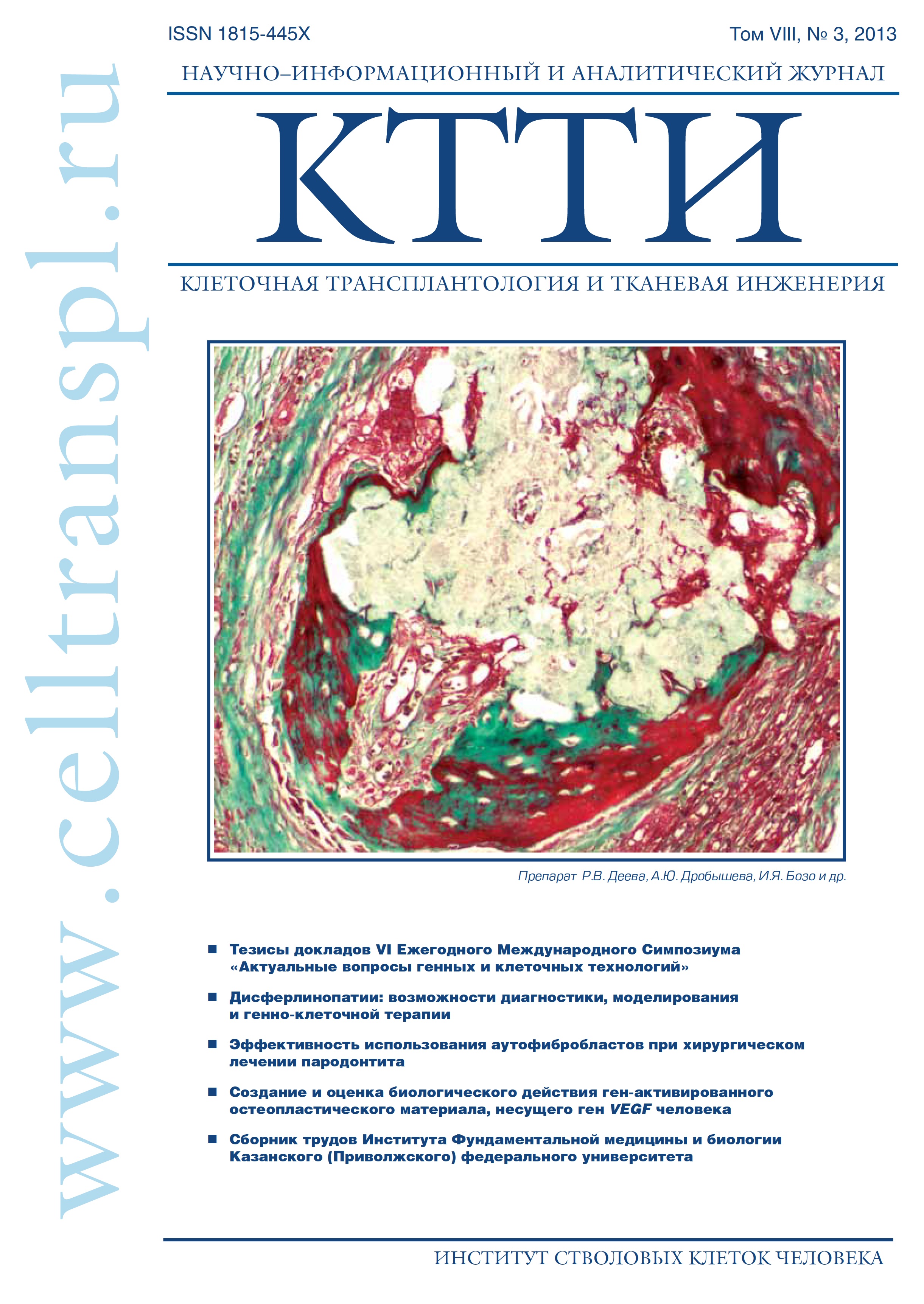Characterization of rat myofibroblasts isolated from liver portal tracts using explantation technique
- Authors: Miyanovich O.1, Katina M.N1, Rizvanov A.A1, Kiyasov A.P1
-
Affiliations:
- Kazan Federal University
- Issue: Vol 8, No 3 (2013)
- Pages: 119-124
- Section: Articles
- Submitted: 05.01.2023
- Published: 15.10.2013
- URL: https://genescells.ru/2313-1829/article/view/120622
- DOI: https://doi.org/10.23868/gc120622
- ID: 120622
Cite item
Abstract
Today there is no effective approach to treat liver fibrosis and the only way is transplantation of donors' liver. Investigation of molecular-cellular mechanisms of liver fibrosis can help to discover new ways of slowing down or even reverse the process of fibrogenesis in liver. For a long time hepatic stellate cells were undeservingly blamed for being the major causer of liver fibrosis, because they were considered as the main source of myofibroblasts, that synthesize connective tissue extracellular matrix. In this particular work explantation approach was used to isolate cell culture from portal tracts. It was shown that received cells are portal fibroblasts, and, just as hepatic stellate cells, in case of liver alteration can differentiate in myofibroblasts, that express а-smooth muscle actin. During long-term cultivation it was shown that portal myofibroblasts can differentiate into fibroblasts and back on late passages. So, we can conclude, that there is a potency to reverse the process of fibrogenesis in liver.
Full Text
About the authors
O. Miyanovich
Kazan Federal UniversityKazan
M. N Katina
Kazan Federal UniversityKazan
A. A Rizvanov
Kazan Federal UniversityKazan
A. P Kiyasov
Kazan Federal UniversityKazan
References
- Ramadori G. and Saile B. Portal tract fibrogenesis in the liver. Lab. Invest. 2004; 84(2): 153-9.
- Novo E., di Bonzo L.V., Cannito S. et al. Hepatic myofibroblasts: a heterogeneous population of multifunctional cells in liver fibrogenesis. Int. J. Biochem. Cell Biol. 2009; 41(11): 2089-93.
- Bosselut N., Housset C., Marcelo P. et al. Distinct proteomic features of two fibrogenic liver cell populations: hepatic stellate cells and portal myofibroblasts. Proteomics 2010; 10(5): 1017-28.
- Iwaisako K., Brenner D.A., Kisseleva T. What's new in liver fibrosis? The origin of myofibroblasts in liver fibrosis. J. Gastroenterol. Hepatol. 2012; 27(Suppl 2): 65-8.
- Forbes S.J., Parola M. Liver fibrogenic cells. Best Pract Res Clin. Gastroenterol. 2011; 25(2): 207-17.
- Novo E., Povero D., Busletta C. et al. The biphasic nature of hypoxia-induced directional migration of activated human hepatic stellate cells. J. Pathol. 2012; 226(4): 588-97.
- Katalin D. Architectural and immunohistochemical characterization of small bile ducts harboring hepatic adult stem cells. In: Doctoral School of Pathology. Budapest: Semmelweis University; 2011.
- Ye Z., Houssein H.S., Mahato R.I. Bioconjugation of oligonucleotides for treating liver fibrosis. Oligonucleotides 2007; 17(4): 349-404.
- Parola M. and Pinzani M. Hepatic wound repair. Fibrogen. Tissue Repair. 2009; 2(1): 4.
- Cassiman D., Libbrecht L., Desmet V. et al. Hepatic stellate cell/myofibroblast subpopulations in fibrotic human and rat livers. J. Hepatol. 2002; 36(2): 200-9.
- Asahina K. Hepatic stellate cell progenitor cells. J. Gastroenterol. Hepatol. 2012; 27(Suppl 2): 80-4.
- Brenner D.A., Kisseleva T., Scholten D. et al. Origin of myofibroblasts in liver fibrosis. Fibrogenesis Tissue Repair. 2012; 5(Suppl 1): S17.
- Kisseleva T., Brenner D.A. Anti-fibrogenic strategies and the regression of fibrosis. Best Pract. Res. Clin. Gastroenterol. 2011; 25(2): 305-17.
- Генин А.М., Капланский А.С. Биоэтические правила проведения исследований на человеке и животных в авиационной, космической и морской медицине. Авиакосмическая и экологическая медицина 2001; 4: 14-20.
- Gordana Vunjak-Novakovic R.I.F. Culture of cells for tissue engineering. John Wiley & Sons, Inc.; 2006.
- Clouzeau-Girard H., Guyot C., Combe C. et al. Effects of bile acids on biliary epithelial cell proliferation and portal fibroblast activation using rat liver slices. Lab. Invest. 2006; 86(3): 275-85.
- Zhao R., Duncan S.A. Embryonic development of the liver. Hepatology 2005; 41(5): 956-67.
- Kamo N., Yasuchika K., Fujii H. et al. Two populations of Thy1-positive mesenchymal cells regulate in vitro maturation of hepatic progenitor cells. Am. J. Physiol. Gastrointest. Liver Physiol. 2007; 292(2): G526-34.
- Dudas J., Mansuroglu T., Batusic D. et al. Thy-1 is an in vivo and in vitro marker of liver myofibroblasts. Cell Tissue Res. 2007; 329(3): 503-14.
- Миянович О., Ризванов А.А., Киясов А.П. Выделение и культивирование миофибробластов печени крыс методом эксплантации. Клеточная трансплантология и клеточная инженерия 2012; 7(3): 112-15.
- Bataller R., Brenner D.A. Liver fibrosis. J. Clin. Invest. 2005; 115(2): 209-18.
- Dezso K., Jelnes P., Laszlo V. et al. Thy-1 is expressed in hepatic myofibroblasts and not oval cells in stem cell-mediated liver regeneration. Am. J. Pathol. 2007; 171(5): 1529-37.
- Dranoff J.A., Wells R.G. Portal fibroblasts: Underappreciated mediators of biliary fibrosis. Hepatology 2010; 51(4): 1438-44.
- Gaca M.D., Zhou X., Issa R. et al. Basement membrane-like matrix inhibits proliferation and collagen synthesis by activated rat hepatic stellate cells: evidence for matrix-dependent deactivation of stellate cells. Matrix Biol. 2003; 22(3): 229-39.
- Sohara N., Znoyko I., Levy M.T. et al. Reversal of activation of human myofibroblast-like cells by culture on a basement membrane-like substrate. J. Hepatol. 2002; 37(2): 214-21.
Supplementary files










